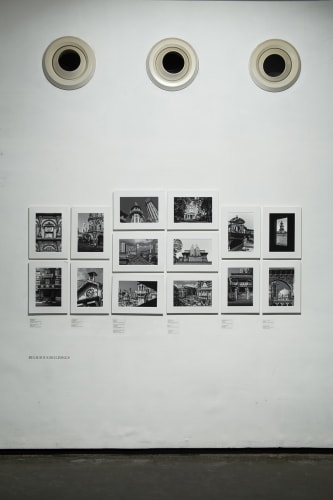I have regularly been asked about how I found these buildings. I could say – with tenacity.
But, perhaps, I should just say that it was a combination of observation, legwork and sometimes, a feeling in the gut. As a photographer of the streets it isn’t uncommon to develop an instinct for a somewhat 180 degree vision of happenings on the ground. My peculiar pursuit, however, with time trained me to include in my line of vision the additional 90 degrees of the vertical plane. Quite regularly, in the middle of a conversation, while walking, my eyes would involuntarily travel up the facade to the pediments of buildings. Over the years I started to identify certain features of buildings – Victorian, Neo-Gothic, Art Deco, or even Bombay’s vernacular – which seemed to be likely locations to find a clock.
Sometimes I would enter a lane following the spire of a church or the minaret of a mosque spotted from a distance. On occasions I would make a detour, just to double-check, if I remembered a building that had a dynamic elevation or stood at an important junction of roads, like the Majestic Building opposite Regal Cinema or the Guru Singh Saheb Gurudwara, a short walk from Dadar T. T. Last year, I spotted a clock when I casually turned to look out of a taxi while stuck in traffic on Duncan Road, my road blocked by a tangle of laden handcarts. I had passed through this road before too but this was, perhaps, to be my day of revelation. Serendipity, as you see, played no small a role. Another time, I chanced upon a scan of a vintage postcard pinned on a soft board in my friend’s office and discovered that the Dwarkadhish Temple had a clock.
I often felt as though Bombay’s clocks were following me, teasing me, just as I was hot in pursuit of them. My mother one day, informed me about the Prince’s Triumphal Arch, an arched gateway which stands at an awkward angle, surrounded by hawkers’ stalls and its clock concealed by a tree, near Cadbury’s junction. Now, it seemed people around me, those not really in the habit of ‘seeing’, had also begun to get infected with a bit of my madness. But, mostly, people informed me of ones that I had already spotted.
Then in early 2016, I put up a social media post requesting friends to keep a look out. That led me to being alerted about a sundial at the Kamala Nehru Park, the clock on the Gramdevi Devalaya at Gamdevi and an unusual one above the elevator door of the Punjab National Bank Building on P. M. Road. A friend remembering her childhood in the back lanes of Sion told me about Shanti Sadan Apartments, popularly known as ‘Ghadiwala building’ by locals. That clock no longer exists. Mrs. Shah, on whose terrace the clock once stood, these days, puts out a bowl of water there for the birds.
In late 1996, by the time I had begun photographing Bombay’s public clocks, most of them were in a state of disrepair, their purpose one could argue, already redundant. Some were lost to callousness, others to apathy. A dubious fire burnt down the Swadeshi Mills at Kurla and its clock tower in 2004. For years I argued with myself whether the square clock above the entrance of the Kaivalyadhama Yoga Center on Marine Drive would fit my definition of a public clock. Then one day the clock was gone and I have, since then, scolded myself for over-thinking rather than shooting that photograph. Monsoon time leakages, the scourge of the city’s buildings, corroded the iron parts of the Aurora Cinema clock in the mid-80s. A glass pane covers the hole on the dome of the Indian Sailor’s Home where I had once photographed a clock. That clock was sent for repairs and no one bothered when it never came back.
For nearly 23 years I have walked around Mumbai as though looking for my daily fix. I now have a list of 86 on an excel sheet. A significant percentage of these are in the Fort precinct – the original business district in colonial Bombay where appointments must have been important and time might have been money. The rest are scattered and exist in clusters in the residential and mercantile localities through the city and the reasons for their existence range from desiring a landmark to serving the neighbourhood or simply to know when to pray to ones Gods.
- Chirodeep Chaudhuri. January, 2020


